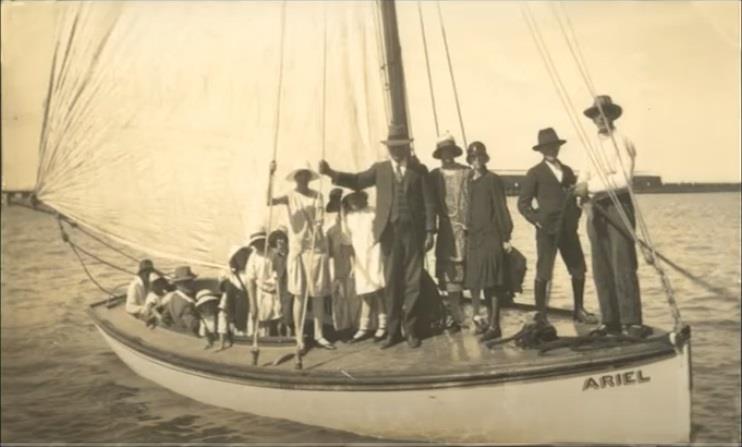
Where is the Couta's true home?
by Southern Woodenboat Sailing 1 Apr 2021 23:12 PDT

ARIEL in her home town of Portland, Victoria © Southern Woodenboat Sailing
First and foremost we are delighted to welcome to the SWS fold an incredibly talented young writer and sailor. We've had the pleasure of knowing Oscar Perri for most of his life. A charmer with a passion for old boats that he no doubt inherits from the fine skills of his father Antony. This is Oscar's first article and we look forward to many, many more. Having spent all his summers on the Bellarine Peninsula, Oscar had assumed Queenscliff to be the natural home of the famous Couta boat... turns out, where there's wood, there's a story worth following.
If you asked for 'the home of the Couta boat', most people say Queenscliff, some might suggest Sorrento, but very few would extend it too far Further East or West along coast of Victoria. Few still might suggest Portland.
The gaff rig centre-boarder is one of the most iconic of Australia's native boat designs, and it's history and development can be traced right along the state's coastline.
The Couta boat has an almost supernatural ability to bring out any competitiveness and obsession in wooden boat lovers, and South Melbourne shipwright Henry Murray's sarcastic and indignant letters to the editor of the Portland Guardian from in 1891 show that it this Couta-curse has plagued Victorian boaties for centuries.
As such it is no surprise that there is much contention as to exactly who's head the plaudits should go to, and which harbour they first made their home.
Much of the credit for the design development and building of the fleet is duly given to late 19th to early 20th century Queenscliff designer/builders Mitchell Lacco, Andrew Hansen, and Peter Locke, while Murray's 28 foot WANDERER built in 1890 is held to be the probable prototype for the class. Though Maritime Historian Gary Kerr says fishermen all along the Victorian coastline who commissioned the building if the boats had a major influence on how the class developed, and many of the features that set them apart from other local designs.
As railways reached the further out fishing communities, enabled fishermen along the coast to transport more of their catch across the state. This growth in the industry allowed for bigger fleets and investment in better boats to increase catch sizes. Kerr says there was a healthy competitiveness between fishermen and boat builders, which propelled the development of couta boats, and refining their features for better performance as ocean fishing boats.
There are no particularly major regional differences between the centre-boarders favoured by fishermen working different parts of the coastline, due to the fact that boats were being built in the same yards that commissioned from across the state, and the fishing grounds for the main target species, Barracouta, was similar along Victorian waters.
Speed became important for the advantage of reaching these locations ahead of other boats, and this competition soon led to regattas being held between fleets, a well followed local sport and occasion for townspeople in the early 20th century.
Kerr, a professional fisherman of 59 years, is responsible for possibly the first modern restorations of a Couta, as well as a fair deal of the work in collecting and compiling the storied history of the class. He developed an admiration for the boats while working them as an aspiring young, "couta-ing" off Portland bay in the Southern ocean. When ARIEL, which had been built in 1927 by J R Jones in Melbourne for Portland Stevedores to take holidaymakers on 20c tours around the bay, came looking for a new owner in the early 1970's, Kerr says he felt little choice but to take on the task of returning her to former glory.
He says there was little information on the methods of how the centreboarders were built at the time, aside from what he could garner from the 'old-timers' who had worked on the boats when they were in their prime, but almost nothing was written down. Mistakes were made, including a very overestimated account on how much ballast they were meant to take, but many of these were quickly identified and resolved once ARIEL got back out on the water.
Around 1975, once ARIEL was fully restored, Kerr invited boatbuilder Tim Phillips out for a sail around Portland bay. Phillips had already developed an interest in the class, but Kerr says seeing the work he had done to Ariel was a part of what inspired Phillips to his fervorous efforts to do the same for the Couta boats in Port Phillip bay, learning the craft of building and repairing Couta's from renowned masters, working to restoring a strong fleet and eventually establishing the Wooden Boat Shop in Sorrento
Nowadays there are only two Couta boats left in Portland, a town with a storied history intrinsically tied to the ocean, it is where the first European settlers arrived on the Victorian coast, and fishing has remained a constant source of work for locals.
Kerr says many of the local boats were lost to strong seas before a breakwater was installed for a safer harbour, and fishermen mainly replaced them with cray boats to follow trends of demands and higher prices. But the Couta's will always keep a place in the town as the craft that opened up the sea for local fishermen, and grew the local industry to the peak of its strength.
Article Written for SWS by Oscar Perri
This article has been republished by permission from southernwoodenboatsailing.com